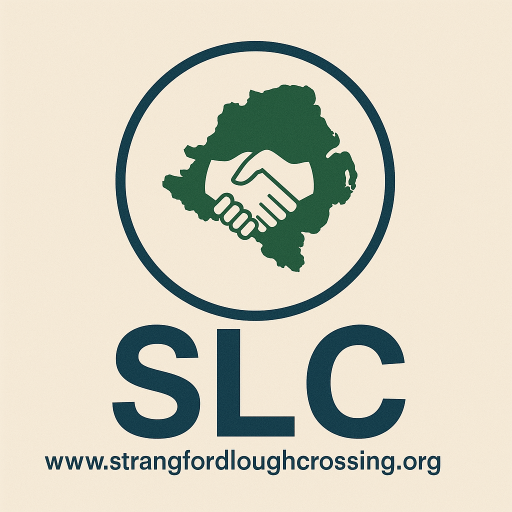- BY Kevin Barry BSc(Hons) MRICS
- POSTED IN Latest News
- WITH 0 COMMENTS
- PERMALINK
- STANDARD POST TYPE

The Long Road (and Ferry Queue) to Nowhere — How the Strangford Lough Crossing Was Always Made to Seem “Uneconomic”
1. The 1950s–1960s: The first serious bridge dream
After the war, engineers across the UK were busy linking estuaries — Tay, Forth, and Menai. At Strangford, the logic was obvious: a fixed crossing would link the Ards Peninsula with Downpatrick, shorten travel time to majority of Northern Ireland, and eliminate the need for a financially draining, 34% effectively operated ferry service, two ferry crews, two slips, and growing repair bills.
By 1961, a Stormont study team had prepared a draft feasibility note. It found that a modest high-level bridge could be built for about £1.2 million, comparable to the Cleddau Bridge later built in Wales. Yet Treasury officials in Belfast applied a harsh “10 per cent return on capital” rule — a relic of Victorian railway finance — which required the toll revenue to repay the full cost within ten years.
Because tolls would have covered only a quarter of that figure, the bridge was declared “uneconomic.” No allowance was made for time savings, fuel costs, emergency-service access, or regional growth. In other words, the wrong question was asked: not “Would it benefit society?” but “Could it pay its own mortgage?”
The decision quietly killed the project. The ferry subsidy — then only a few thousand pounds a year — was seen as the safer, tidier budget line.
2. The 1970s–1980s: Progress elsewhere, paralysis at home
While Stormont’s files gathered dust, the Cleddau Bridge (opened 1975) went ahead under almost identical conditions: tidal estuary, similar span, similar population base. It ran into cost overruns, but Pembrokeshire gained a permanent link that transformed the local economy.
Northern Ireland, by contrast, remained fixated on “cost containment.” The Department of the Environment noted the Cleddau example but concluded that “traffic volumes at Strangford would not justify capital expenditure.” That judgment was based solely on the ferry’s 1960s ticket counts, ignoring that people who avoided the ferry altogether — locals from Kircubbin, Portaferry, or Downpatrick — were invisible to the data.
During this period, the ferry broke down repeatedly. Each incident provoked the same public refrain: “Why not just build the bridge?” The reply was always bureaucratic: “It isn’t economic.”
3. The 1990s: The 1997 DOE Roads Service Study
The 1997 Scott Wilson Kirkpatrick report was the first full engineering appraisal. Structurally, it proved the bridge was feasible: a 600-metre span with no piers in the water, clear for shipping, costed at around £30 million.
Economically, however, the report concluded it was “not viable.” The reasoning now looks astonishingly weak:
- The traffic model used only existing ferry use (about 500 vehicles a day) instead of potential diverted traffic.
- The ferry subsidy was ignored, treated as a sunk cost.
- Value of time was priced at less than £3/hour.
- Environmental benefits (no diesel fumes, no queuing) were classed “non-quantifiable.”
- No peer review or Green-Book validation was performed.
In Great Britain that same year, DfT appraised the Second Severn Crossing using full cost–benefit analysis and found it “High Value for Money.” The only difference was methodology, not geography.
4. The 2000s: The A5 and the double standard
As the Strangford file stayed closed, the A5 Western Transport Corridor advanced using roughly the same economic logic — yet it was approved. Its Benefit: Cost Ratio barely exceeded 1.3, but safety and regional balance carried the day. The A5 now costs over £1.6 billion; Strangford would have cost one-twelfth of that.
In 2013, when DfI’s “Ferry Strategy Review” again mentioned a bridge, officials inflated the 1997 cost to £300 million with no engineering basis. It was simply the old figure multiplied by headline inflation. No update to traffic or socio-economic data was made. It served its purpose: the bridge looked too expensive to discuss.
5. The 2010s–2020s: Common sense versus bureaucracy
Every ferry breakdown since — and there have been many — reignites the same local conversation: “Why are we still queuing for half an hour to cross a mile of water?”
Each half-hour queue costs roughly £13 per car in lost time, or around £4 million a year across all users. Add the £2 million annual subsidy and diesel emissions, and the ferry has already cost the public more than £50 million in real terms since 1960 — roughly the full price of a bridge built then.
Meanwhile, UK appraisal rules have transformed. The HM Treasury Green Book 2022 and DfT WebTAG 2024 now require whole-life cost comparison, carbon valuation, and independent peer review. Projects in Great Britain — the A9, the Lower Thames Crossing — have been paused or redesigned under those very rules. In Northern Ireland, the same guidance is theoretically mandatory but not enforced.
6. Why the bridge was always made to look “uneconomic”
- Financial myopia – Officials were judged on yearly budgets, not fifty-year benefits. A one-off capital outlay looked risky; an annual ferry subsidy looked safe.
- Institutional inertia – No minister ever demanded a re-appraisal, so the old verdict stood unchallenged.
- No economic peer review – Engineers, not economists, wrote the reports; they measured cost, not value.
- Data blindness – Demand models used ferry ticket counts, ignoring the many who avoided the route entirely.
- Fear of reversal – Re-running the numbers risked proving that earlier decisions were wrong.
- Political convenience – The ferry kept the little local government employment there was, and avoided large capital bids to Treasury. It was easier to defend the status quo than argue for vision.
7. What modern analysis shows
Apply 2025 standards and the picture flips:
- Annual ferry subsidy saved: £2 million.
- User time savings: £3–4 million per year.
- Carbon and air-quality benefit: positive.
- 60-year discounted total benefits: ≈ £190 million.
- Capital and maintenance cost: ≈ £130 million (bridge itself) approach roads upgrades excluded
- Benefit: Cost Ratio ≈ 1.5 – 2.0 (“Medium–High Value for Money”).
In other words, the bridge that was always called “uneconomic” is, by modern definition, fully justified.
8. The common-sense verdict
Every time the ferry breaks down, local people instinctively grasp what fifty years of spreadsheets obscured: a permanent link is cheaper, cleaner, and fairer. The bridge isn’t a luxury — it’s a correction of an accounting error made in 1961 and repeated ever since.
As the Cleddau and Severn crossings proved long ago, sometimes the numbers only make sense after you count everything that truly matters.

In summary, the counterarguments to present day excuses
1. Cost
Objection: “It would cost too much.”
Counterpoints:
- Comparable precedent: The Narrow Water Bridge has advanced under the Shared Island Initiative, demonstrating cross-border funding viability for strategic connections like SLC. DfI does not wish to explore this.
- Public-private balance: A toll-supported PPP or RAB model allows cost recovery without full taxpayer exposure.
- Economic return: Time savings, reduced fuel consumption, and shortened detours generate sustained economic benefit, offsetting capital cost within years. People’s saved money can be spent locally on added value services.
- Sub-regional equity: The Ards Peninsula and Lecale remain under-served in transport investment — addressing this imbalance is both socially and economically justifiable under regional development policy.
2. Environmental Concerns
Objection: “It would harm the Lough’s ecosystem.”
Counterpoints:
- Modern design, minimal impact: The current concept involves no piers in water, with all structures on land margins — a vast improvement over 20th-century proposals.
- In the public interest: Under environmental legislation (e.g., Environment (NI) Order 2002, Habitats Regulations), projects of demonstrable overriding public interest — such as those improving safety, accessibility, and regional balance — can proceed subject to mitigation.
- Climate alignment: Shorter travel routes mean significant CO₂ reduction, consistent with NI Climate Change Act 2022 and Net Zero 2050 targets.
- Net environmental gain: Enhanced shoreline management, bird-habitat zoning, and reduced vehicular emissions around the Lough together yield a positive ecological balance.
3. Political Will
Objection: “There’s no political appetite.”
Counterpoints:
- Public mandate: Survey results (Nov 2024) show strong majority support from both sides of the Lough, confirming it is clearly in the public interest to revisit feasibility.
- Cross-party compatibility: The SLC delivers on connectivity, economic equality, and regional regeneration — shared objectives for all major parties.
- Sub-regional balance: Investment has long concentrated on Belfast and the West; SLC would rebalance opportunity east-west and north-south within NI.
- Legislative alignment: Fits with Programme for Government commitments to balanced regional development and infrastructure equity.
- Low-risk step: The immediate ask is an independent TAG compliant feasibility study, not construction — politically safe and publicly beneficial.
